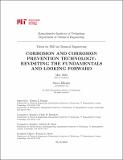Corrosion and Corrosion Prevention Technology: Revisiting the Fundamentals and Looking Forward
Author(s)
Effendy, Surya
DownloadThesis PDF (43.90Mb)
Advisor
Bazant, Martin Z.
Terms of use
Metadata
Show full item recordAbstract
Corrosion science is a well-established field with over a century's worth of research and development. This venerable state of affairs is in line with the importance of the topic, which is indispensable in a global economy so dependent on metals as structural and commercial goods. Nevertheless, to an external observer, it seems as if most major scientific developments in the field are in the distant past. The current state of affairs, in which empirical testing dominates corrosion research, only serves to strengthen this impression. The dominance of empirical approach reflects a certain state of mind in the community, namely, that corrosion science is a complex topic which does not lend itself well to quantitative analysis. This belief comes at a cost, since empirical findings tend to be difficult to generalize, resulting in a slow and resource-intensive development of corrosion-resistant and corrosion-prevention technologies.
From another perspective, given recent developments in theoretical, computational, and experimental techniques, it seems unusual that major theories in corrosion science has remained as they were several decades ago. Indeed, I believe that the the time is ripe to reassess corrosion research in some depth, beginning with fundamental corrosion science, into corrosion prevention technology, and finally into the application of modern methods for corrosion research. Naturally, being a single person, it is not possible to discuss the entirety of corrosion science and corrosion prevention technology, and this thesis represents only the small number of key insights that I have developed in the past four years.
I explore anode / cathode separation and differential aeration as examples of well-established ideas which prove more complex than they are conventionally understood in the field. I show that significant evidence cited in favor of anode / cathode separation can be explaining using the more parsimonious localized corrosion hypothesis. Follow-up experimental work indicates that additional electrochemical phenomena dominates the response of both hypotheses, and establishes autocatalysis and electrophoresis as potential key unmodeled phenomena in the field.
I then delve into the design of anti-corrosion coatings, which suffers from the aforementioned excessive focus on empirical analysis. This section of the thesis is divided into two components, the former focusing on the formation and evolution of osmotic blisters, while the latter focuses on the interaction between the coating and the electrolyte it is immersed in. The former leads to fundamental, unifying insights on the failure of anti-corrosion coatings, with three dimensionless numbers governing the rupture, delamination, and visibility of blisters, while the latter leads to a useful tool which can be used to quantify species mobility and coating hydrophilicity using relatively simple measurements. The models presented in both works have been validated against experimental data, and promise to accelerate the pace of coating development in the field.
Finally, I return to basic considerations of data requirement in the design of anti-corrosion coatings and propose a physics-based kernel method for reducing the data requirement by several order of magnitudes. The method uses electrochemical impedance spectroscopy (EIS), defect-on-coating equivalent circuit, machine learning, and high-throughput experimentation to allow the exploration of the large design space of anti-corrosion coatings. As an illustrative example of the application of EIS and the manipulation of equivalent circuits from first principle, I present a combined experimental / theoretical work on the flow behavior of redox flow batteries (RFBs), which reveals the self-similarity of fibrous carbon electrodes and leads to a useful tool for flow analyses.
To round off the topic of data requirement, I analyze fundamental concepts in EIS data inversion, which can be used to extract additional key features relevant to the prediction of coating failure. This theoretical work dissects the key assumptions made in EIS data inversion, identifies failures in said assumptions, and builds a more coherent algorithm which outperforms existing programs designed to fulfill the same task. With the tools and discoveries made in this thesis, I hope to embolden future corrosion scientists and engineers to foray beyond the current qualitative paradigm of corrosion science.
Date issued
2022-05Department
Massachusetts Institute of Technology. Department of Chemical EngineeringPublisher
Massachusetts Institute of Technology